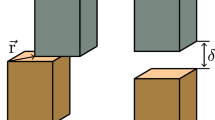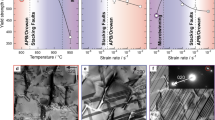Abstract
Stronger and more resistant alloys are required in order to increase the performance and efficiency of jet engines and gas turbines. This will eventually require planar faults engineering, or a complete understanding of the effects of composition and temperature on the various planar faults that arise as a result of shearing of the \(\gamma ^\prime \) precipitates. In the current study, a combined scheme consisting of the density functional theory, the quasi-harmonic Debye model, and the axial Ising model, in conjunction with a quasistatic approach is used to assess the effects of composition and temperature of a series of pseudo-binary alloys based on the \(({\mathrm{Ni}}_{75-x}{\mathrm{X}}_{x}){\mathrm{Al}}_{25}\) system using distinct relaxation schemes to assess observed differences. Our calculations reveal that the (111) superlattice intrinsic stacking fault energies in these systems decline modestly with temperature between \(0\,\)K and \(1000\,\)K.




Similar content being viewed by others
References
C.M.F. Rae and R.C. Reed.: Acta Mater. 55(3):1067–81 (2007). https://doi.org/10.1016/j.actamat.2006.09.026.
L. Vitos, J. O. Nilsson and B. Johansson: Acta Mater. 54:3821–26 (2006). https://doi.org/10.1016/j.actamat.2006.04.013.
Y. Qi and R. K. Mishra: Phys. Rev. B, 75:224105–10, 2007. https://doi.org/10.1103/physrevb.75.224105.
C. B. Carter and S. M. Holmes: Philos. Mag., 35:1161–72, 1977. https://doi.org/10.1080/14786437708232942.
H. Suzuki: J. Phys. Soc. Jpn., 17:322--25, 1962. https://doi.org/10.1143/jpsj.17.322.
V. A. Vorontsov, L. Kovarik, M. J. Mills, and C. M. F. Rae: Acta Mater., 60(12):4866–78, 2012. https://doi.org/10.1016/j.actamat.2012.05.014.
G. B. Viswanathan, R. Shi, A. Genc, V. A. Vorontsov, L. Kovarik, C. M. F. Rae, and M. J. Mills: Scripta Mater., 94:5–8, 2015. https://doi.org/10.1016/j.scriptamat.2014.06.032.
K. V. Vamsi and S. Karthikeyan: in Superalloys 2012, pp. 521--530. Wiley (2012). https://doi.org/10.1016/j.scriptamat.2015.02.020.
K. V. Vamsi and S. Karthikeyan: in Superalloys 2012. Wiley, 2012, pp. 521–30. https://doi.org/10.1002/9781118516430.ch57.
P.J.H. Denteneer and W. van Haeringen: J. Phys. C, 20(32):L883, 1987.
A. Breidi, J. Allen, and A. Mottura: Acta Mater., 145:97–108, 2018. https://doi.org/10.1016/j.actamat.2017.11.042.
A. Breidi, J. Allen, and A. Mottura: Phys. Status Solidi (b), 2017. https://doi.org/10.1002/pssb.201600839.
M.A. Blanco, E. Francisco, and V. Luaña.: Comput. Phys. Commun., 158(1):57–72, 2004. https://doi.org/10.1016/j.comphy.2003.12.001.
Y. Mishima, S. Ochiai, and T. Suzuki: Acta Metall., 33(6):1161–69, 1985. https://doi.org/10.1016/0001-6160(85)90211-1.
A. V. Ruban, V.A. Popov, V.K. Portnoi, and V.I. Bogdanov. Philos. Mag., 94(1):20--34, 2014. https://doi.org/10.1080/14786435.2013.838647.
C. Jiang and B. Gleeson: Scripta Mater., 55(5):433–36, 2006. https://doi.org/10.1016/j.scriptamat.2006.05.016.
A. V. Ruban and H. L. Skriver: Phys. Rev. B, 55:856–74, 1997. https://doi.org/10.1103/physrevb.55.856.
J. M. Cowley: J. Appl. Phys., 21(1):24–30, 1950. https://doi.org/10.1063/1.1699415.
B. E. Warren: X-ray Diffraction. New York, Dover, 1990.
P. Hohenberg and W. Kohn.: Phys. Rev., 136(3B):B864–71, 1964. https://doi.org/10.1103/physrev.136.b864.
W. Kohn and L. J. Sham.: Phys. Rev., 140(4A):A1133–38, 1965. https://doi.org/10.1103/physrev.140.a1133.
G. Kresse and D. Joubert.: Phys. Rev. B, 59:1758–1775, 1999. https://doi.org/10.1103/physrevb.59.1758.
G. Kresse and J. Furthmüller.: Comput. Mater. Sci., 6(1):15–50, 1996. https://doi.org/10.1016/0927-0256(96)00008-0.
P. E. Blöchl: Phys. Rev. B, 50:17953–79, 1994. https://doi.org/10.1103/physrevb.50.17953.
J. P. Perdew, K. Burke, and M. Ernzerhof.: Phys. Rev. Lett., 77(18):3865–68, 1996. https://doi.org/10.1103/physrevlett.77.3865.
W.H. Press, S.A. Teukolsky, W.T. Vetterling, and B.P. Flannery: Numerical Recipes 3rd Edition: The Art of Scientific Computing. Cambridge University Press, Cambridge, 2007. ISBN 9780521880688.
C. A. Swenson: J. Phys. Chem. Solids, 29(8):1337–48, 1968. https://doi.org/10.1016/0022-3697(68)90185-6.
E. F. Wasserman: in Handbook of Ferromagnetic Materials, Handbook of Ferromagnetic Materials, vol. 5. Elsevier, 1990, pp. 237–322. https://doi.org/10.1016/s1574-9304(05)80063-x.
O.L. Anderson and D.G. Isaak: Elastic Constants of Mantle Minerals at High Temperature. American Geophysical Union, 2013, pp. 64–97. ISBN 9781118668191. https://doi.org/10.1029/rf002p0064.
Y. Wang, J. J. Wang, H. Zhang, V. R. Manga, S. L. Shang, L.-Q. Chen, and Z.-K. Liu: J. Phys., 2010, vol. 22(22), art. no. 225404.
S.-L. Shang, H. Zhang, Y. Wang, and Z.-K. Liu: J. Phys., 2010, vol. 22(37), art. no. 375403.
O. Gülseren and R. E. Cohen.: Phys. Rev. B, 2002, vol. 65, art. no. 064103, https://doi.org/10.1103/physrevb.65.064103.
I. Bleskov, T. Hickel, J. Neugebauer, and A. Ruban.: Phys. Rev. B, 2016, vol. 93, art. no. 214115, https://doi.org/10.1103/physrevb.93.214115.
V. I. Razumovskiy, A. Reyes-Huamantinco, P. Puschnig, and A. V. Ruban.: Phys. Rev. B, 2016, vol. 93, art. no. 054111, https://doi.org/10.1103/physrevb.93.054111.
C. Kittel: Introduction to Solid State Physics, 7th edition. Wiley, New York, 1996
Y.-K. Kim, D. Kim, H.-K. Kim, C.-S. Oh, and B.-J. Lee: Int. J. Plast., 79:153–175, 2016. https://doi.org/10.1016/j.ijplas.2015.12.008.
Acknowledgments
This study made use of these computational facilities: (a) the University of Birmingham’s BlueBEAR HPC service (http://www.birmingham.ac.uk/bear), (b) MidPlus Regional HPC Center (www.hpc-midlands-plus.ac.uk), and (c) Beskow cluster (https://www.pdc.kth.se/hpc-services/computing-systems/beskow-1.737436). The authors are therefore very much grateful and would like to thank them for making this study possible. The authors would like, as well, to thank the EPSRC (Grant EP/M021874/1) and EU FP7 (Grant GA109937) for their financial support. Part of this study (A. Breidi) has been carried out within the framework of the EUROfusion Consortium and has received funding from the Euratom research and training programme 2014-2018 under the Grant Agreement No. 633053 and from the RCUK Energy Programme [Grant Number EP/P012450/1]. The views and opinions expressed herein do not necessarily reflect those of the European Commission.
Author information
Authors and Affiliations
Corresponding author
Additional information
Manuscript submitted March 18, 2018.
Rights and permissions
About this article
Cite this article
Allen, J.D.T., Mottura, A. & Breidi, A. First-Principles Modeling of the Temperature Dependence for the Superlattice Intrinsic Stacking Fault Energies in L1\(_2\) Ni\(_{75-x}\)X\(_x\)Al\(_{25}\) Alloys. Metall Mater Trans A 49, 4167–4172 (2018). https://doi.org/10.1007/s11661-018-4763-4
Received:
Published:
Issue Date:
DOI: https://doi.org/10.1007/s11661-018-4763-4




